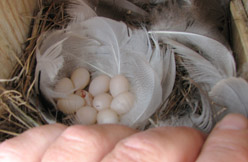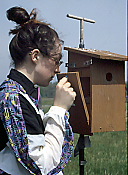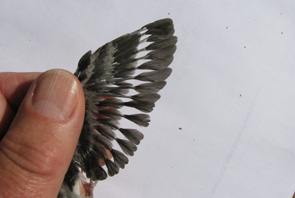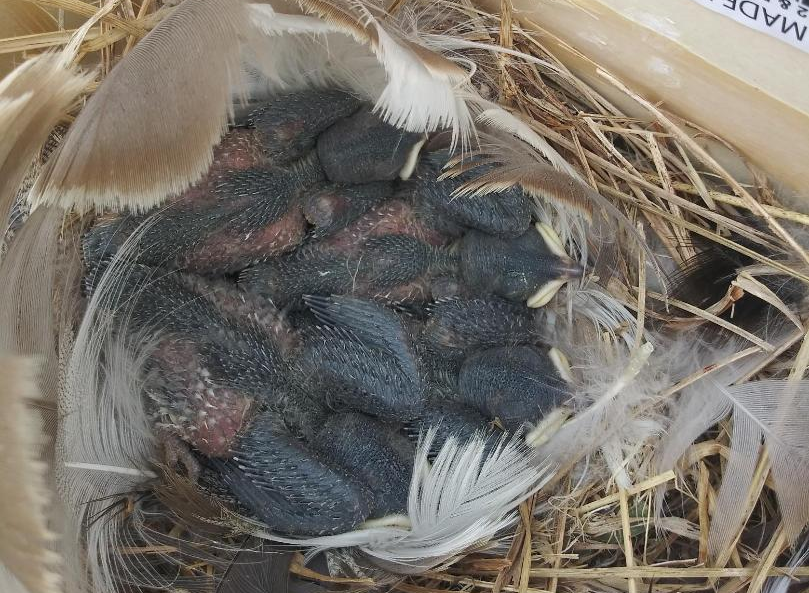What are Tree Swallow box checks?
Making Tree Swallow box checks simply involves opening nest boxes briefly to examine their contents, and then recording what’s seen on a Box Check Record sheet. Box checks can, of course, be used for nesting attempts of other bird species.
Most Box Check Record sheets have fields for date, time, box number, species using the box, nest construction stage, number of eggs, number of young, and remarks. Click link above to see example and also see below.

How do you check a Tree Swallow box?
- Approach the box from the side if possible, not the front.
- Give a series of whistles to warn an incubating or brooding female you are coming, so she can exit before you arrive at the box.
- Unfasten the door gently and open it just enough to peek inside.
- If there is an adult swallow inside close the door carefully and move on to another box, making a note to return to this box later.
- If there is no adult inside open the door wide enough to view the whole interior.
- Note pertinent box contents data on the Box Check Record sheet.
- Any broken eggs or dead nestlings you find should be removed and disposed of well away from the box.
- Refasten the door securely and move on.

Warning! Some types of colonial wasps build nests in birdhouses, anchoring their nests on the underside of the roof. Make it a habit to check for wasp nests so they can be removed while they are small. Rubbing the attachment surface with a bar of soap helps deter wasps from building.
Won’t opening boxes disturb the swallows?
- They clearly aren’t pleased to have you poking around in their nests. This is one reason to make checking boxes the last thing you do on a visit.
- Some Tree Swallows may give alarm calls which can attract a crowd. Some may dive on you, just missing your head.
- However, Tree Swallows almost never desert a box that’s simply been checked.
However, there are a few situations when Tree Swallows are sensitive to disturbance. At these times you should not open boxes or if you must, do so very carefully. These are:
- On mornings when females are laying eggs wait until after 9:00 A.M.
- During incubation, open the box a crack and peek in to make sure the female is not inside before making a full check. If the female is inside, close the box, back away and wait until she leaves before checking.
- Don’t ever check boxes at night! Females disturbed after dark could desert, even if they are incubating eggs or brooding small young.
- Don’t open a box with nestlings older than 12 days, unless you must in order to control parasitic mites. Disturbing older nestlings could cause them to jump out of the box prematurely, fall to the ground where they will not be cared for by their parents and will die.
- Look carefully at the wing of the 12 day old nestling below. Note how the flight feathers of the wing have partly erupted from their sheaths and resemble little paintbrushes.
- If you don’t know the exact age of the nestlings in a box, and you find ones with wing feathers more erupted than in this example, leave them alone!
- If you take these precautions box checks shouldn’t endanger your birds.

How often should you make Tree Swallow box checks? How do you know when a box has laying or incubating females. And how do you know when nestlings are 13 days old or older?
- It’s best to make box checks at least once a week, the more often the better since there are some crucial events, such as last egg date and hatch date, it’s important to know.
- Early in the season you would normally check every box on each visit to your project.
- However, once a female has finished laying her eggs you should rely on your Control Sheet for tracking nesting attempts to guide checks at that box.
- The Control Sheet displays the status of every nest, including nestling age, so you’ll know which boxes need checking and when, so unnecessary checks and potential problems can be avoided.
- We suggest you refer to your Control Sheet at home before visits and make a list of boxes to be checked.
- Photo below of nestlings below being monitored from Bill Zagar of Michigan.

Here are Box Check data fields to record:
- Date and Time: Some people omit time.
- Box Number: You should have a numbering system for your boxes. It helps to have numbers marked on the box doors.
- Species: You can use the banders’ four-letter code. For instance; Tree Swallow = TRES, Eastern Bluebird = EABB, House Wren = HOWR, etc.
- Nest: Stage of nest construction measured in shape and completeness of cup vegetation, and amount of feathers. These are all rather subjective, but give you a system for comparing nests. (Note: We usually stop recording nest construction data once eggs are laid).
- Here are our codes for nest construction status:
- MT = empty box
- FG = few grasses or other vegetation
- 1/4 C = ring of vegetation present but skimpy
- 1/2 C = ring clearly built but cup lacking
- 3/4 C = nest cup is shaped but box floor still visible
- CC = complete nest cup formed with box floor covered
- FF = few feathers
- SF = some feathers
- MF = many feathers
- VMF = very many feathers
- Eggs: Number of eggs present. Tree Swallows lay one egg per day, but sometimes females skip a day if weather is poor.
- A skip of several days often means another female has taken over the nest and has started to lay her own eggs. Takeover females usually cover the eggs of the previous female.
- Occasionally competitors, either other swallows or competing species, throw out one or more eggs.
- Note: you may have to remove eggs one at a time to get an accurate count. Lift them very carefully, place them in a cupped hand, then replace them gently in the cup.
- Young: Number of young present. As with eggs you may need to remove young to get an accurate count. Ease your fingers carefully underneath each, one at a time. Grasp its body, lift it out, and place it into your other hand. If they grab nest material in their feet give them a minute to relax their grasp. Older nestlings can be squirmy. Don’t drop! Be sure to replace nestlings directly into the nest cup, not out on the edges, and deposit them in the cup very gently so they aren’t injured by hard pieces of vegetation.
- Remarks: You might want to note dead or missing eggs or young, undersized young, behavior of adults during the check, takeover concerns, presence of wasps, unusual nest material, weather issues, etc.

What should you do if you find a dead nestling?
- Remove it and dispose of it far from boxes so its scent doesn’t draw predators.
After making Tree Swallow box checks what do you do with all this monitoring data?
- You take it home for transfer into the Nest Box Record sheets you keep for each box, using either the short form or the long form.
————————————————————————————-
Home: Tree Swallow Nest Box Projects
Creating Tree Swallow Nest Box Projects
Spring Return
Nesting Season Behavior
Song and Calls
Nest Site Claiming
Pair Formation
Nest Building
Bird Flight
Mating and Paternity
Diary of One Season at Salmon Creek
Monitoring Nest Boxes and Keeping Records
Making Box Checks Keeping Box Records Control Sheets Season Summaries Print Sheets
Banding Your Tree Swallows Banding Adults Banding Nestlings
Tree Swallows in Research Research Bibliography Glossary of Terms